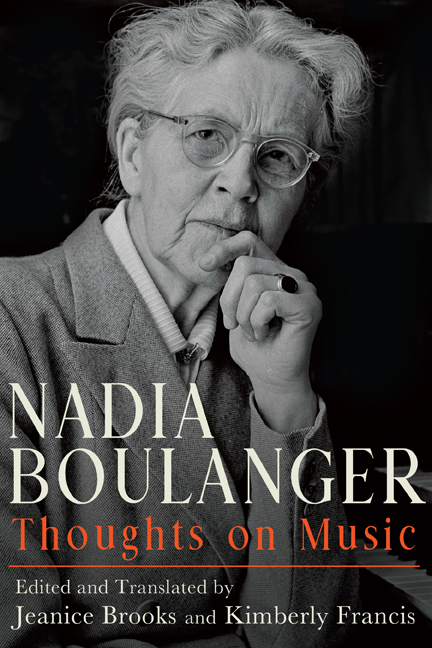Book contents
- Frontmatter
- Contents
- List of Illustrations
- Acknowledgments
- Editorial Apparatus and Critical Notes
- Note on Translations
- List of Abbreviations
- Timeline of Nadia Boulanger’s Life
- Introduction
- Part One Journalism, Criticism, Tributes
- Part Two Lectures, Classes, Broadcasts
- Bibliography of Nadia Boulanger’s Published Writing
- General Bibliography
- Index
“Igor Markevitch, Dinu Lipatti, Jean Françaix” Spectateur 3, no. 93 (March 11, 1947): 2 (complete text)
Published online by Cambridge University Press: 15 October 2020
- Frontmatter
- Contents
- List of Illustrations
- Acknowledgments
- Editorial Apparatus and Critical Notes
- Note on Translations
- List of Abbreviations
- Timeline of Nadia Boulanger’s Life
- Introduction
- Part One Journalism, Criticism, Tributes
- Part Two Lectures, Classes, Broadcasts
- Bibliography of Nadia Boulanger’s Published Writing
- General Bibliography
- Index
Summary
Concerts Reviewed
February 16, 1947 (Théâtre des Champs-Elysées, Société des Concerts)
Orchestral Suite no. 2, B minor, BWV 1067, J. S. Bach
Piano Concerto, A minor, op. 16, Edvard Grieg
Symphony, D minor, op. 48, César Franck
February 20, 1947 (Salle Gaveau, Concerts Colonne)
Suite Symphonique, Luc Balmer
Concertino, Willy Burkhard
Fantaisie Concertante, Albert Moeschinger
Third Concerto, Richard Sturzenegger
Suite, Henri Gagnebin
February 26, 1947 (Salle Gaveau, Trio Moyse)
Trio Sonata, Johann Sebastian Bach
Duo for Two Flutes, George Frideric Handel
“Mia speranza adorate,” K. 416, Wolfgang Amadeus Mozart
Duo, Neubour
Trois psaumes, Arthur Honegger
Quatre Études rythmiques, Bohuslav Martinù
Cinq Quatrains, “La Rose,” and “Le Rossignol,” Marcel Delannoy
Burlesque, Marcel Moyse
Musique de cour, Jean Françaix
Just as a room, a museum gallery, an outfit, a menu, or a speech is composed, so too is a concert program. Why do artists think of this only so rarely? Works are grouped haphazardly, as if preparing or managing one's effects had no importance. From monotony we move to confusion; here, because everything is similar; there, because everything is in contrast. Yet everyone is aware that there are works that are impossible together and contrasts that are harmonious.
An image often comes to my mind. In the Metropolitan, two masterpieces by El Greco—the landscape of Toledo and the portrait of Cardinal Ximenes—produce an almost unbearable effect side by side. One must hide one to see the other. Their colors are mutually destructive. And yet, God knows how beautiful each is on its own.
In contrast, one dreams of placing Frans Hals's Sorceress next to the still life by Cézanne that is isolated several rooms away. There is harmony between these two paintings: they enhance one another; each makes the other sing. Cases such as this are extremely common in music and explain many feelings of uneasiness, many errors in judgment. One enters where one should have exited or goes first into the most intimate rooms; the chapel opens onto the kitchen, small pieces of furniture are placed in the largest rooms, heavy sideboards in the bedrooms, authentic Louis XVI armchairs near Lévitan chairs. It would require just a bit of care, good sense, and taste to remedy this state of things (over which we do not have a monopoly). The thing is to take pleasure in it, with conviction.
- Type
- Chapter
- Information
- Nadia BoulangerThoughts on Music, pp. 263 - 266Publisher: Boydell & BrewerPrint publication year: 2020



